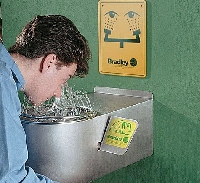Employee safety equipment saves money
By Catalogs Editorial Staff

Investing in employee safety equipment conserves resources and saves money
Safety equipment not only protects employees but saves countless dollars in Workers’ Compensation contributions. Investing in employee safety equipment saves money and conserves resources because employee safety is related directly to a company’s Workers’ Compensation rates.
Occupational Safety and Health Administration, also referred to as OSHA, requirements – along with common sense practices – should guide employers as they provide the necessary tools for workers and employee safety equipment. Ethical employers should put employee safety and well-being at the forefront of daily operations. Employers should make every effort to train their employees about the specific work place hazards that exist as part of their type of operation, and that are faced every day by their employees.
The utilization of OSHA guidelines and requirements keeps all employees at arm’s length from most common hazards. Proper training of employees all but eliminates workplace dangers.
There is no substitution for common sense and random follow up. Every business owner should institute protocols that include utilization of guidelines, monitoring of adherence to those guidelines, and continual re-checking of standards and procedures.
~
Instituting training programs on the correct use of employee safety equipment reinforces procedures all ready in place. Safety equipment manufacturers often offer on site input to support employee training. Videos, brochures and online demonstrations of correct procedures, installation, use and maintenance of safety equipment are vitally important in validating a company’s investment in both safety and property.
The OSHA guidelines and requirements are very specific with respect to certain protective measures. These industrial safety supplies include, but are not limited to, eye protection, first aid stations, emergency response training, foot protection, hand protection, head protection, hearing conservation, ergonomics, machine guarding, respiratory protection, tools safety, welding protection and fall protection. Most safety protocols can be found in an OSHA safety handbook and equipment safety can be found through local or online suppliers who handle Underwriters Laboratory (UL) listed equipment.
Quota based schedules can sometimes lead to safety oversights. Schedule deadlines at times put safety on the back burner and put employees at risk of injury. What seems to be a revenue generating measure may actually put your company at serious risk of resource loss, both human and monetary.
A company’s best resource as an employer is their employee. A safe work place and environment leads to increased production as employees who feel safe and understand safety measures can concentrate on their work-related tasks while implementing procedures. Injured employees who have to miss scheduled work time are then replaced with, at times, less qualified or less experienced personnel. This leads to production issues and quality shortfalls.
Equipment that is regularly checked for safety concerns benefits from the inspection by way of less “break-downs’. Equipment that is up-and-running at peak performance generates increased revenue. Equipment down-time on a man-hour basis takes away from profits in manufacturing. Equipment and tool break downs in construction results in delays and increased man hour costs not generated as line item when the bidding process takes place. Safety is directly related to equipment maintenance and service.
It is up to the employer to smooth the transition between safety and production, while staying within guidelines set by OSHA and safety equipment manufacturers. A strict company-wide protocol regarding safety protocols and use of safety equipment conserves resources at a multitude of levels.
References:
State Farm: Employee Safety
EHSToday
Popular Savings Offers











